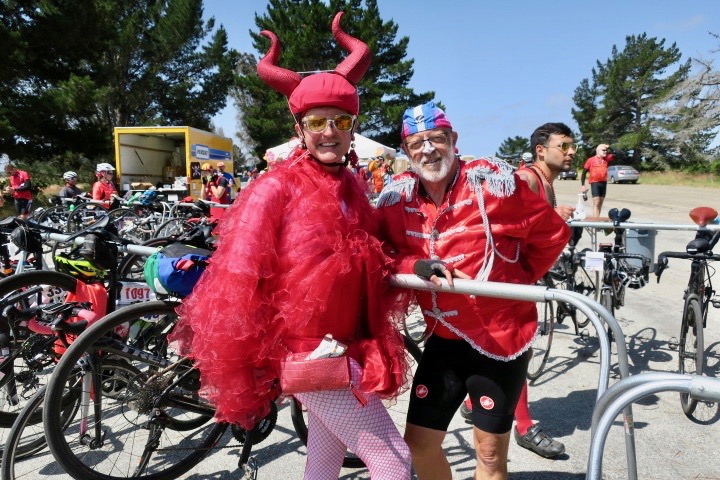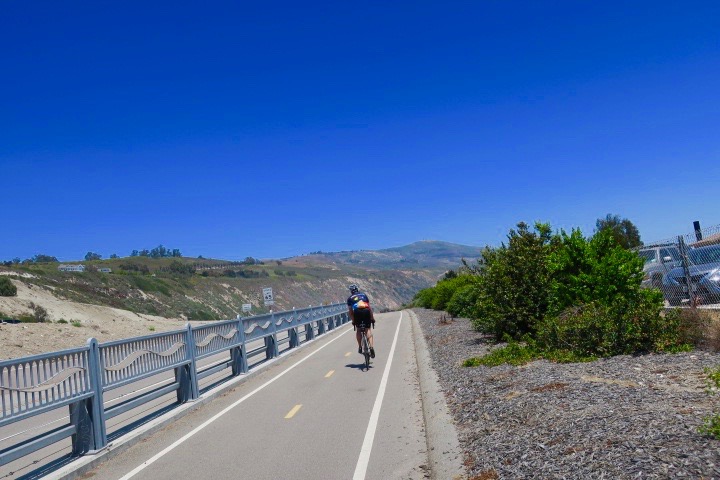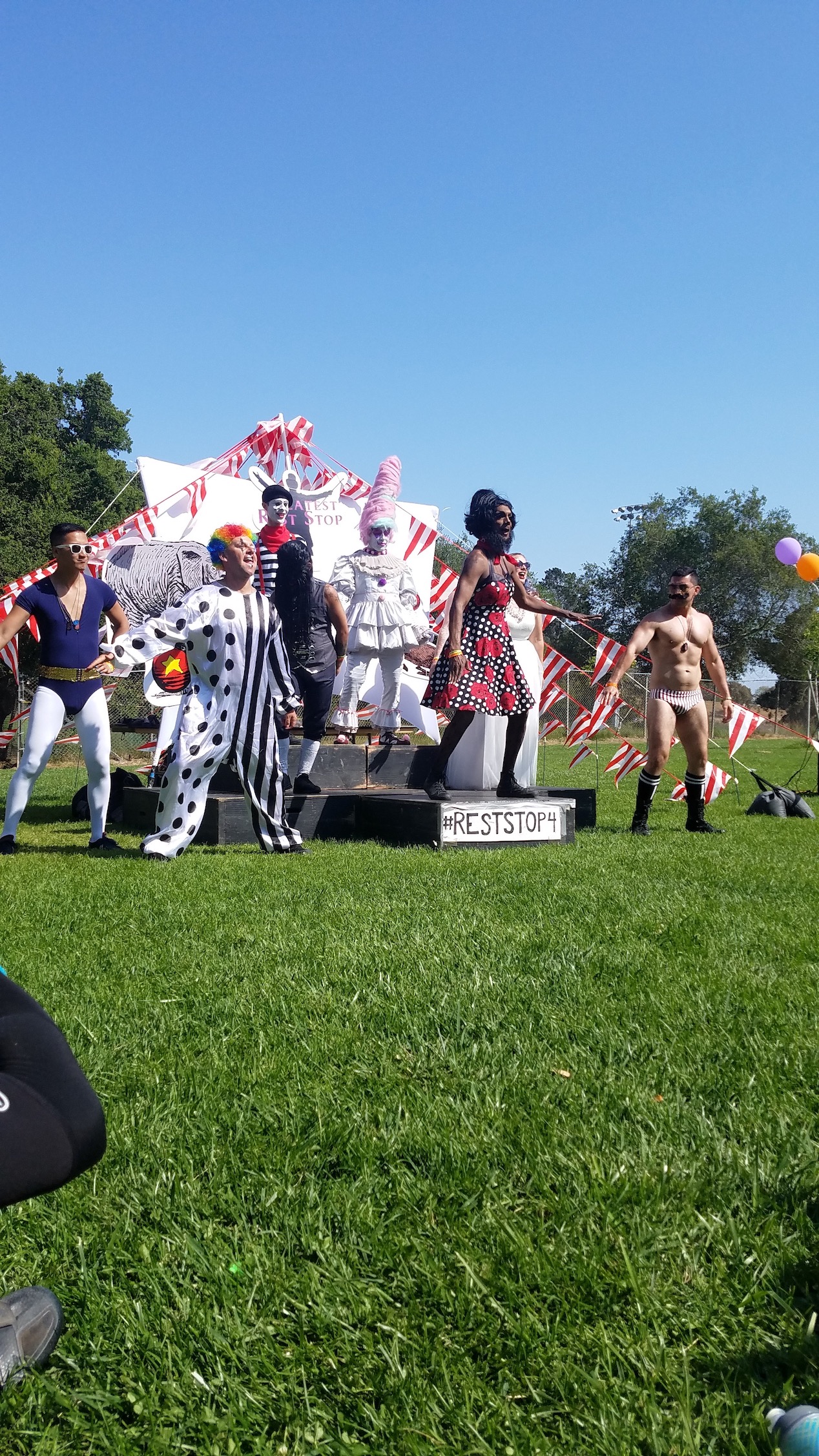My Other Bike is a Vessel of Light
Originally posted on June 15, 2018 at 0:01 am
Since Halloween, I have been fundraising for AIDS/LifeCycle to earn my spot riding with roughly 2,200 other cyclists and 500 volunteers from San Francisco to Los Angeles. The ride brings awareness to the streets of California and our internet communities; the funds bring needed financial support to organizations who provide education, community, and medical access to people living with or at risk of contracting HIV/AIDS. We each needed to raise a minimum of $3,000 to participate in this supported ride, and I was proud of my community for stepping up to raise that amount. Collectively, we raised $16.6 million for various programs in California, where there is both a high concentration of people affected by the epidemic and infrastructure in place to support them, so long as there’s funding.

June 3-June 9 was the Big Ride, 551 miles down the California Coast. At 5:30 in the morning, as we were lining up for our very first ride out of the Cow Palace in San Francisco, I overheard the man behind me talk about the mountain bike races in Utah he’d used as his training rides. His friend agreed that he’d also been mainly mountain biking these past few months in preparation, though he was located in South Carolina. I turned to ask them more about their cycling, but our line merged with the flock and we were herded away from each other. While I set out to do this ride purely from a position of charity (and for the sake of a new experience), my writerly interest had been piqued. I knew some other cyclists here weren’t “just” roadies, weren’t “just” charity ride participants, but people who loved spinning the pedals, any pedals really. I wanted to meet them, those folks cloaked in lycra and road shoes.

I’m pretty shy, but over seven days of passing the chamois butter, helping apply sunblock, shouting “on your left,” and listening to almost 3,000 people snore and fart in their sleep, even the shyest of us made conversation. One woman in front of me on Day Two had all the makings of a mountain biker: high socks over muscled calves, mountain bike helmet with visor, club fit jersey, utilitarian road bike. I sprinted up the hill to catch her and asked if she rode trails.
“No, I’m a commuter in San Francisco,” she said, asking where I got my assumptions. “Oh, the shop I go to sort of outfitted me with this stuff, I guess. I didn’t really think about it.”

Another rider chased after me after I passed him on Day Three. We did a bit of cat-and-mouse before we tempered our pace and jawed about our love of riding. He was a former road racer but was currently enamored with mountain biking, though he wasn’t as good at it. We talked about switchbacks and I gave him some tips on using his front brake for control, something that makes a roadie’s skin crawl with the memory of road rash.
The Cretins, on the other hand, are bike punks who’ve been riding as a team of increasing numbers since the first Cretin started in 2013. This year, the 30-member team raised $136,709 in lifesaving donations. They race on the bikes they have, fixed-gears, with the slogan “fixing to save lives.” The Cretins, with their fixies and matching kits and tattoos, were easily identifiable, but other non-roadies blended in.
I noticed people’s legs as I passed them. They couldn’t all be roadies, but no one appeared to shave their legs besides drag queens and a few women. A lot of my new friends had gotten into cycling because of not just charity rides, but this specific ride. Tony, who housed me in San Francisco, started training a year in advance of his first AIDS/LifeCycle ride 20 years ago. He bought a bike and walked through the wardrobe into Narnia: new friends, hobbies, goals. Others were in a similar boat. It was the charity that brought them to the ride, and the ride that brought them closer to their bodies and their selves, deeper into the sport of cycling.

At the vigil on the beach in Ventura, on the final night of camping before riding across the finish line in Los Angeles, that idea crystallized. At sundown, the Sisters of Perpetual Indulgence, a usually irreverent group of queer nuns in fabulous outfits, gave a speech. The candle used to light the others is from the previous year’s vigil, and so on for the past 25 years. The flame passes on, the hope for a cure and the memories of those lost to the epidemic never die. We walked in silence toward the beach. The brightness of the candles expanded around us like ants overcoming a peach as the flame was passed from person to person, lighting a candle without sacrificing one’s own light. A bicycle in the sand came into view.

The Sisters said a prayer I couldn’t hear, but it wasn’t my place to nudge forward. People leaned against each other and wept, but not in darkness. The light of 3,000 candles illuminates even the most cimmerian moments. It is in that light that these cyclists and volunteers decide to ride, train, fundraise, and wake up at 4 a.m. or earlier for a week. It is in that light that our own flame burned and got us over each climb and down the descents some might otherwise be scared to attempt.
We took our candles to the ocean. We stood on the shore. Line by line, we edged up to the waves that approached us and caught the water in the paper cups that protected our flames from wind.
The next day, riding down Highway 1 into Los Angeles, past the Malibu mansions and hapless surfer bros opening their doors into our peloton without looking as the route shifted us up, down, and around the hills of southern California, my own trajectory shifted. I’d wanted to find my story about multi-modal cyclists. The truth is, we all ride for the same reason: it makes us feel alive. It ultimately doesn’t matter if we ride track, trail, or road, if we follow arrows, sharrows, or blazes. The AIDS/LifeCycle was the ultimate celebration of that feeling of living in our bodies, the euphoria I feel even when my knees hurt, because my knees are doing so much for me.

With a group like this, many of whom have endured the loss of a whole generation of family and friends, entire communities seemingly wiped from the planet as it by tsunami, that celebration and appreciation of our current lives are as important as the remembrance of lives lost to the epidemic. They call it The Love Bubble. I had been so focused on pedaling, hydration, and sleep, pinned into the small viewfinder of specific cyclists, so enamored with my own love of two wheels whirring beneath me that I hadn’t paid attention to the love around me. That final day, as we crossed the finish line one by one, whatever type of cycling we enjoyed outside that ride was peripheral. We were riding for our lives.
